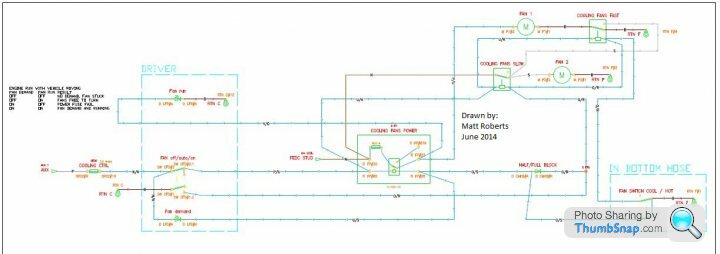Rover V8 cooling changes--EWP?
Discussion
neillr said:
My understanding is that it depends on having some flow through the bypass to heat the thermostat pellet and keep the thermostat open. If the differential pressure across the bypass valve is small (for example, at low revs, when the pump is not working at capacity), perhaps there is not enough flow to keep the thermostat open.
Anyway, why would you want to have ANY bypass flow when you're trying to reduce the engine temperature?
I think the internals of the stat are cleverly designed to maintain the canister temperature under all conditions from fully open to fully closed and don't need a residual flow through the bypass. However, supposing you were using a part that did require a residual flow and had been designed to provide that, the flow rate required to flush stagnant water out of the bypass would be negligibly small compared to the radiator flow. I see this is one of the big advantages of the entry stat over the conventional top stat - it closes off the bypass and ensures full flow through the rad. Does your top stat installation close off the bypass?Anyway, why would you want to have ANY bypass flow when you're trying to reduce the engine temperature?
The entry stat design is also less prone to temperature cycles because it's effectively mixing hot and cold water directly at the point it enters the engine - with a top stat you can get massive overshoots where the stat starts to open and then dumps a radiator full of cold water into the hot engine leading to massive transients, and the system can take a while to settle down.
If you have temperature stability issues it may be worth checking the design of the secondary circuits such as cabin heater, degas (header), EGR mixer coolers or whatever else you have to see whether there is anything funny going on there. For example I've heard of poorly design installations which applied cap pressure to the rad inlet instead of the outlet which were vulnerable to cavitation under some conditions.
EDIT: Responding to the comment by MAX_Torque, the Land Rover PRT entry stat is pressure/flow sensitive as well as temperature sensitive - it is designed to allow the bypass to open slightly at high revs when the pump is trying to flow too much coolant for the radiator. Doing this maintains a higher flow through the engine for better protection against hot spots while maintaining enough flow through the rad for overall cooling.
Edited by GreenV8S on Saturday 29th October 16:20
GreenV8S said:
EDIT: Responding to the comment by MAX_Torque, the Land Rover PRT entry stat is pressure/flow sensitive as well as temperature sensitive - it is designed to allow the bypass to open slightly at high revs when the pump is trying to flow too much coolant for the radiator. Doing this maintains a higher flow through the engine for better protection against hot spots while maintaining enough flow through the rad for overall cooling.
That is exactly what I measured with an infrared thermometer. Under heavy load, the temperature difference between the thermostat outlet hose and the bottom radiator hose would actually *increase* over the temperature difference when unloaded. And then never quite cool off. In other words, when the engine is working, the thermostat was mixing more bypass flow into the pump inlet. That's the opposite of what would be ideal, isn't it? Under heavy load, you'd want to get nothing but coolant from the bottom radiator hose and no bypass coolant.Edited by GreenV8S on Saturday 29th October 16:20
Gassing Station | Engines & Drivetrain | Top of Page | What's New | My Stuff




